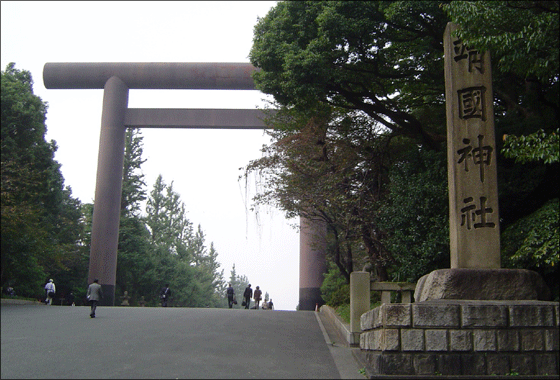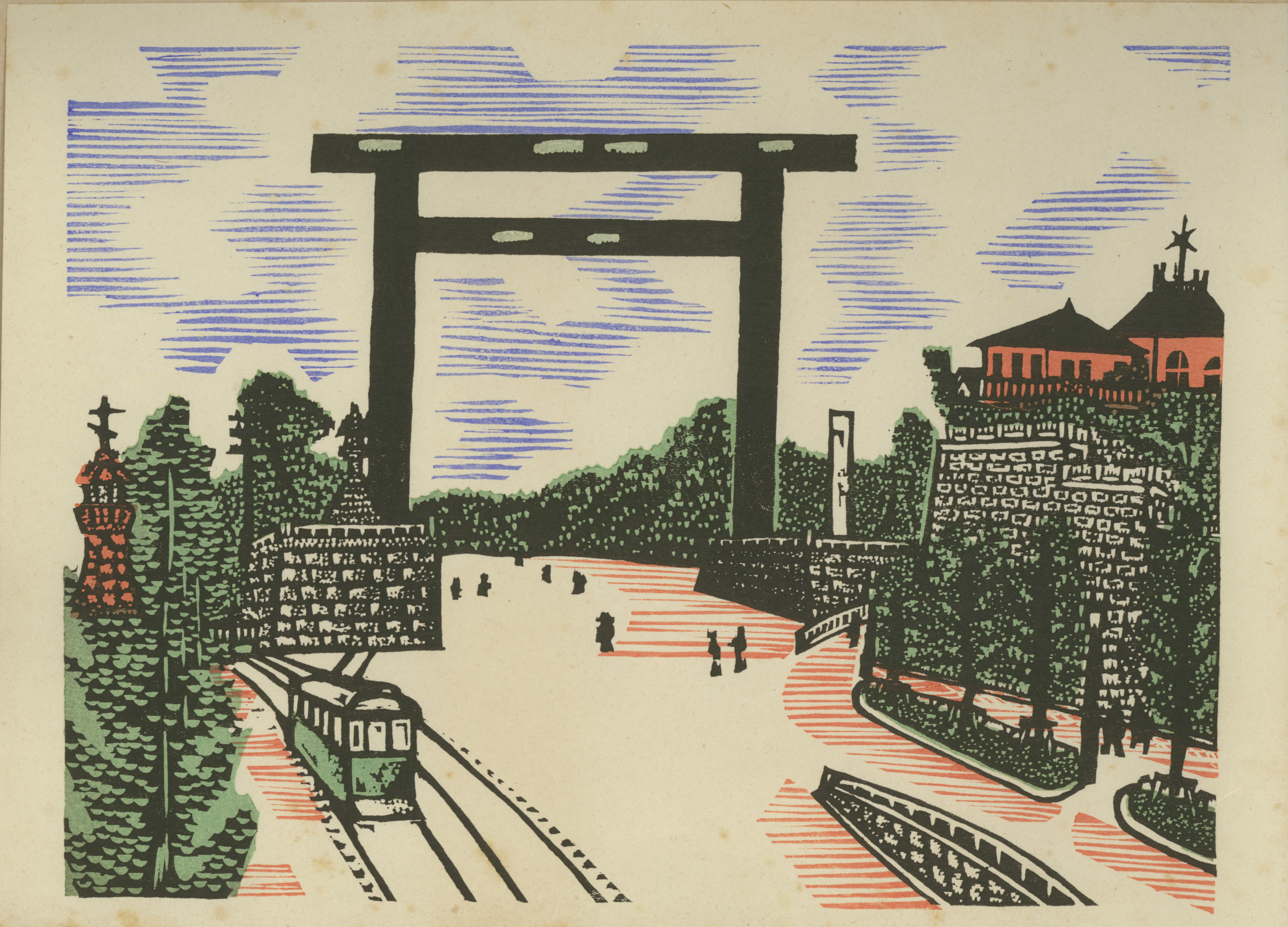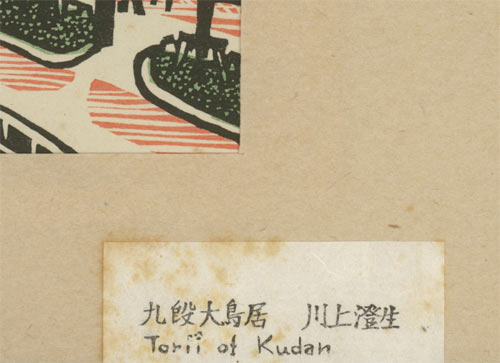About This Print
This print is one of fifteen from the 1945 series Scenes of Last Tokyo (Tokyo kaiko zue) and one of seven new designs created for this series. Smith points out that six of the prints in this series depicted "places with serious imperial resonances," the six being the Nijubashi Bridge at the Imperial Palace, the Akasaka Palace (residence of the Crown Prince), the Meiji Shrine, the Torii (Gateway) at Kudan, the Gate of the Imperial University (alma mater of the most senior bureaucrats of the militarist era), and the Graveyard of Sengaku-ji, burial place of Japan’s most celebrated paragons of loyalty.
The Torii at Yasukuni Shrine in Kudan
Source: British Museum Website http://www.britishmuseum.org/research/search_the_collection_database/search_object_details.aspx?objectid=778877&partid=1&searchText=scenes+of+last+tokyo&fromADBC=ad&toADBC=ad&orig=research%2fsearch_the_collection_database.aspx¤tPage=2
British Museum Curator's comments - Lawrence Smith 2002
"The torii (ceremonial gateway of a Shinto shrine) at the Yasukuni Shrine in Kudan, opposite the moat of the Imperial Palace, is still Japan's biggest. It was re-named Shrine for the Repose of the Country in 1879 to honor the dead of the disturbances surrounding the Restoration of the Emperor Meiji (reigned 1868-1912) and quickly became the national shrine for the war-dead, who from the Sino-Japanese War of 1894-5 onwards became more and more numerous. During the Occupation, it was forbidden for the Emperor and Japanese politicians to go to it, and it remains politically controversial to this day (2002). It was a bold move, therefore, to include it in this series only four months after the cessation of hostilities, but Kawakami was the man to portray it. He had devoted his essentially amateur artistic career to recording the impact of Westernization on Japan from 1868 onwards - a period which he remembered with passionate fondness from his childhood - up to the great Kanto earthquake of 1923 when the remains of most of that culture were almost obliterated by that disaster in Tokyo and Yokohama. He was also an old and trusted friend of Onchi's. In this print he was able to neutralize the current impact of the shrine by shifting it back to a vaguely pre-militaristic period filled with a melancholy and peaceable calm, when trams still ran. It is unclear whether this design was one of the few new ones made for this series (in Kamon, Yasuo, Tozaka, Koji, and Asahi, Akira, Shin Tokyo hyakkei (A Hundred Views of New Tokyo), Tokyo, 1978, p. 52, it is ambiguously referred to as 'added'), or whether Kawakami reactivated an old design of his own."
Source: Los Angeles County Museum of Art http://collectionsonline.lacma.org/mwebcgi/mweb.exe?request=record;id=104179;type=101
Exhibition Wall Label from Japanese Prints: Edo/Tokyo
Along with Yamaguchi Gen’s print of Meiji Shrine, Kawakami’s print is from a series of fifteen prints created by a group of artists in 1945 to memorialize areas of Tokyo damaged or destroyed by war bombings. The great torii of Kudan with its broad approaching road, both built in 1887, led to Yasukuni Shrine, dedicated to the souls of warriors who had died in the name of the Emperor. The print gives a good sense of the geography of the area, the hilly and tree-lined center of the high city.
British Museum Curator's comments - Lawrence Smith 2002
"The torii (ceremonial gateway of a Shinto shrine) at the Yasukuni Shrine in Kudan, opposite the moat of the Imperial Palace, is still Japan's biggest. It was re-named Shrine for the Repose of the Country in 1879 to honor the dead of the disturbances surrounding the Restoration of the Emperor Meiji (reigned 1868-1912) and quickly became the national shrine for the war-dead, who from the Sino-Japanese War of 1894-5 onwards became more and more numerous. During the Occupation, it was forbidden for the Emperor and Japanese politicians to go to it, and it remains politically controversial to this day (2002). It was a bold move, therefore, to include it in this series only four months after the cessation of hostilities, but Kawakami was the man to portray it. He had devoted his essentially amateur artistic career to recording the impact of Westernization on Japan from 1868 onwards - a period which he remembered with passionate fondness from his childhood - up to the great Kanto earthquake of 1923 when the remains of most of that culture were almost obliterated by that disaster in Tokyo and Yokohama. He was also an old and trusted friend of Onchi's. In this print he was able to neutralize the current impact of the shrine by shifting it back to a vaguely pre-militaristic period filled with a melancholy and peaceable calm, when trams still ran. It is unclear whether this design was one of the few new ones made for this series (in Kamon, Yasuo, Tozaka, Koji, and Asahi, Akira, Shin Tokyo hyakkei (A Hundred Views of New Tokyo), Tokyo, 1978, p. 52, it is ambiguously referred to as 'added'), or whether Kawakami reactivated an old design of his own."
Source: Los Angeles County Museum of Art http://collectionsonline.lacma.org/mwebcgi/mweb.exe?request=record;id=104179;type=101
Exhibition Wall Label from Japanese Prints: Edo/Tokyo
Along with Yamaguchi Gen’s print of Meiji Shrine, Kawakami’s print is from a series of fifteen prints created by a group of artists in 1945 to memorialize areas of Tokyo damaged or destroyed by war bombings. The great torii of Kudan with its broad approaching road, both built in 1887, led to Yasukuni Shrine, dedicated to the souls of warriors who had died in the name of the Emperor. The print gives a good sense of the geography of the area, the hilly and tree-lined center of the high city.

Torii at Kudan today
Print Details
| IHL Catalog | #55 |
| Title | Great Torii at Kudan (Kudan dai torii) 九段大鳥居 |
| Series | Scenes of Last Tokyo [also seen translated as Recollections of Tokyo] 東京回顧図会 Tokyo kaiko zue |
| Artist | Sumio Kawakami 川上澄生 (1895-1972) |
| Signature | unsigned |
| Seal | none |
| Publication Date | December 1945 |
| Edition | likely first edition |
| Publisher | Fugaku Shuppansha 富岳出版社, Tokyo, Uemura Masurō 上村益郎 publisher |
| Printer | Hirai Kōichi 平井孝一 |
| Impression | excellent |
| Colors | excellent |
| Condition | good - paper lightly toned, a few light brown spots of foxing, tipped to original folder with original label |
| Genre | sosaku hanga (creative print) |
| Miscellaneous | From the series, Tokyo Kaiko Zue (Scenes of Last Tokyo) consisting of 15 designs. This print is one of the designs contributed byKawakami to the above series. This print is still in the original brown folio with the title attached. |
| Format | chuban |
| H x W Paper | 7 3/4 x 10 3/4 in. (19.7 x 27.3 cm) |
| H x W Image | 7 1/2 x 9 1/2 in. (19 x 24.1 cm) |
| Collections This Print | Los Angeles County Museum of Art M.81.267.24; Museum of Fine Arts Boston 65.1083; The British Museum 1980, 1227, 0.18.5; Carnegie Museum of Art 89.28.709.4; Mead Art Museum at Amherst College 2008.63.5; Portland Art Museum 1996.31.2e; Yokohama Museum of Art 2000-PRJ-002-05 |
| Reference Literature | The Artist's Touch, The Craftsman's Hand: Three Centuries of Japanese Prints from the Portland Art Museum, Maribeth Graybill, Portland Art Museum, Oregon, 2011, p. 297; Terrific Tokyo: A Panorama in Prints from the 1860s to the 1930s,Elizabeth de Sabato Swinton, Worcester Art Museum, 1999. p. 70; JapanesePrints During the Allied Occupation 1945-1952, Lawrence Smith, British Museum Press, 2003, p. 59, figure 43; Modern Japanese Prints: The Twentieth Century, Amanda T. Zehnder, Carnegie Museum of Art, 2009, p. 70. |



